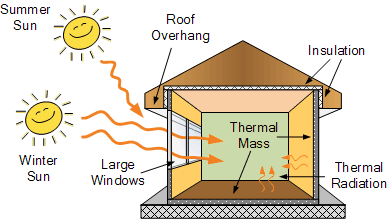Roof Garden
Daniella Lima Smyth
Leadership in Energy and Environmental Design
LEED (Leadership in Energy and Environmental Design) is the most widely used green building rating system in the world. Available for virtually all building types, LEED provides a framework for healthy, highly efficient, and cost-saving green buildings. LEED certification is a globally recognized symbol of sustainability achievement and leadership.
LEED is for all building types and all building phases including new construction, interior fit-outs, operations and maintenance, and core and shell. Unsure of which rating system to use? Check out our interactive Discover LEED tool to get started; then, use the rating system selection guidance to make a final decision.
Millions of people are living, working, and learning in LEED-certified buildings around the world. Learn more about the value of LEED certification.
Reference: https://www.usgbc.org/help/what-leed
Passive Solar

Reference: https://www.energy.gov/energysaver/energy-efficient-home-design/passive-solar-home-design
Light Shelf

A light shelf is a passive architectural device used to reflect natural daylight into a building. 'Bouncing' sunlight off a horizontal surface distributes it more evenly and deeply within a space, whereas direct sunlight can cause glare near an opening, whilst leaving dark areas further in.
Light shelves can be fixed either externally, internally, or both (which often works best in providing an even illumination gradient). They are often designed as part of a broader daylight and shading strategy.
They are generally found on walls facing the sun, as on 'pole-facing walls' would tend to act only as sunshades. On the east and west orientations, they may act as an effective means of reducing direct heat gain and glare but will not bounce light as deeply into space.
Exterior light shelves can be more effective than internal light shelves as they do not radiate as much heat into space and so can help reduce solar heat gain and cooling loads.
Internal light shelves however may be easier to maintain as they can be more accessible and less exposed. In very broad terms, internal light shelves tend to have a depth similar to the height of the opening that they sit below.
Light shelves are commonly made from; timber, glass, plastics, metal panels, plaster, acoustic panels, and so on. The choice of material may be determined by considerations regarding the design of the rest of the building, structural strength, ease of maintenance, cost, durability, and so on. Opacity is not essential, as some transparency can help more-evenly distribute light.
To be able to reflect light up to the ceiling, the upper surface of light shelves should be matte white or diffusely specular, it does not need to be shiny or reflective. Ideally, the ceiling should also be a light color.
Light shelves can:
-
Reduce the need for artificial lighting and so reduce energy consumption.
-
Increase occupant comfort and productivity.
-
Enhance design aesthetics.
Some of the limitations or drawbacks of light shelves are as follows:
-
They tend to be best-suited to mild rather than tropical or desert climates.
-
They can interfere with the installation of sprinkler systems.
-
Their design must be coordinated with windows.
-
They Increase maintenance requirements.
Reference: https://www.designingbuildings.co.uk/wiki/Light_shelf
Trees save energy

Plant deciduous trees, which shed their leaves during the winter. These trees provide shade and block heat during hotter months and, by dropping their leaves in the fall, they admit sunlight in the colder months. Place these trees on the south and west sides of buildings.
Reference: https://www.designingbuildings.co.uk/wiki/Light_shelf